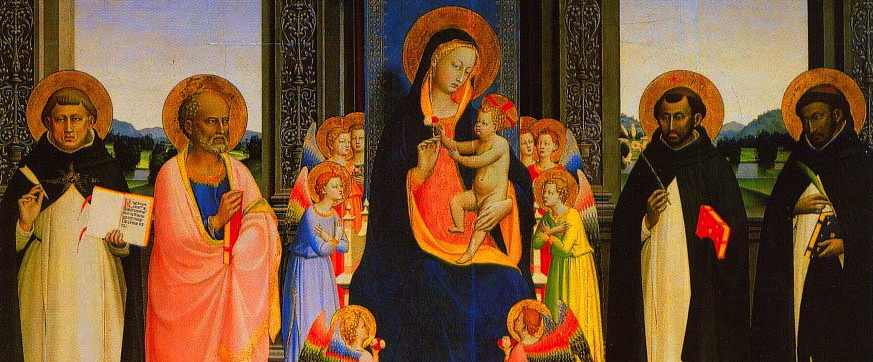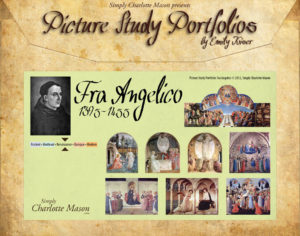Only weeks ago, a long-lost painting by Vincent Van Gogh was discovered in an attic. The art world gasped, then applauded. Even those with little knowledge of the Dutch master were aware that a significant piece of culture had been excavated. A lost treasure found. Van Gogh has been dead for over 120 years.
Every fall, my friend Bonnie presents the following assignment to her high school students: Choose any “cultural artifact” (term borrowed from Andy Crouch) and measure it against the 500 Year Question. Throughout the year, that assignment influences discussions about art, history, music, and a variety of creative endeavors. It becomes a lens through which culture can be viewed and assessed.
How is Van Gogh’s newly-discovered painting relevant to Bonnie’s assignment? Relevant to you?
Join us in reading Fra Angelico and the Five Hundred Year Question by Makoto Fujimura and find out:
It all started again when I visited the Fra Angelico (1395-1455) exhibit at the Met last December.
Behind the splendor of the Christmas cresche, I entered the back hall of the Met. Surprisingly, there was no line (as opposed to the van Gogh drawing exhibit – 45 minutes). But there was a hushed gathering of many, moving about in the darkly lit halls.
I entered the halls and the golden aura of a diminutive Virgin Mary painting greeted me, with her azurite robe, and the Christ child’s supple body, reflecting her humanity — a simple work full of weighty colors. Then I had to close my eyes, after a few seconds of pondering the saturated surface. I realized this was too much to behold, all at once. As I staggered about looking for a blank wall to stare at, almost feeling ashamed to be in the presence of such greatness, I had a “500 year” question pop up in my mind. (What is the 500 Year Question? Read the rest of the article here to find out.)
Take a few minutes and consider the following questions. We’d love to hear your thoughts on any or all of them. Your words will teach and encourage others.
- What ideas from the article resonate with you?
- List a few examples of music, visual art, literature (or other forms of art) that have endured the 500-year test. What are their common characteristics?
- What art, coming out of our current culture (less than 50 years old), do you think will endure the 500-year test? Does it matter? Why?
* * *
If you’d like to learn more about Fra Agelico, Giotto, Michelangelo, or several other of the artists who have endured the 500 Year Question, consider choosing one and exploring with your family. Emily Kiser’s Picture Study Portolios are excellent, easy-to-use resources. Each kit contains the history and several full-color works of the given artist. The study only takes 15 minutes a week, and the prints are ideal for framing and displaying throughout your home. You can order Picture Study Portfolios here.
* * *
If you missed the first few weeks of this series, you can catch up here:
Week 1: Building From Ground Zero: A Conversation with Makoto Fujimura
Week 2: The Beautiful Tears
- A Few of My Favorite Things - February 1, 2021
- The World Needs the Class of 2020 - June 22, 2020
- Books for Boys – A Show and Tell - February 5, 2020


Perhaps, akin to the 400 year silence from Malachi to Matthew, there is a particular cultural darkness that shrouds the souls of mankind, that become the very seeds of hope for a cultural rebirth in art, music, creativity, and the soils of men’s hearts become fertile for the hearing of the Gospel after several hundred years’ of blindness and deafness in the spirit, and the generations fully reap the heaviness of doing right in their own eyes……..?
I’d be curious to know where in the cycle (darkness begets fertile soil begets life) you’d consider our society. Interesting observation – thanks!
Grace in dark places! I am starting the 500 Year Question next week with my students and will be asking it for the rest of the year. Heading to IAM INHABIT so will come back inspired. Thanks for the questions , Julie. It is where God lays His hand on the work for endurance , just like what Italio Calvino said, “A classic is a book that has never finished saying what it has to say.”
Back to say , I hope Mako’s work lasts. Other artists? Not sure who. Writers in the past 50 years would be Lewis and JRRT. Who else? Not sure about Rowlings.
Julie, Thanks for this series. I missed all these (my book was published last month, so I’m just now catching up on the blog reading I missed in all the whirl of promotional activity), but I am greatly enjoying this introduction to Fujimuro; I’d heard of him, even seen a few pieces of his art, but this is the first time I’ve read his words. From this essay, these words stayed me in my tracks:
“If Fra Angelico was born today, he would have a hard time finding anyone to teach him their craft, to be apprenticed, let alone to join an Order. The church would not be the first place a creative genius would look for to be trained in art. That statement alone reveals how much Christians have abdicated our responsibility to steward culture.”
Reading that gave me a response to MF’s earlier question, “what do you want to make today?” I think I want to make a new church Order, an order of artists who apprentice themselves to masters, who give their all to Christ and their art as an act of love. I want to create an Order of Artists so that Christians can begin to reclaim what we’ve lost, so that we can again steward culture responsibly, so that we can embody and enflesh in art (all the arts: music, painting, sculpture, dance, drama, poetry) the Truth we claim to believe in. I think that’s do-able in a day, don’t you?